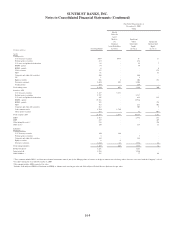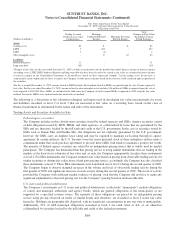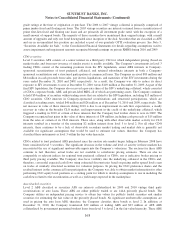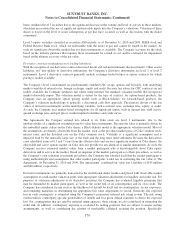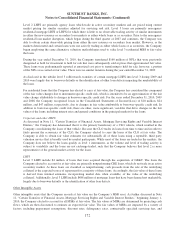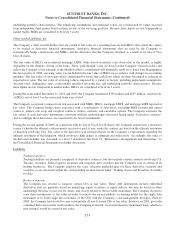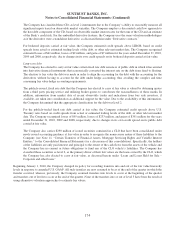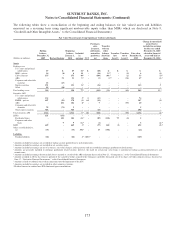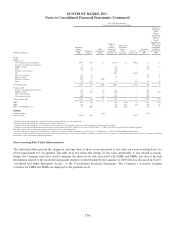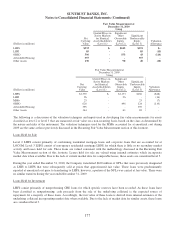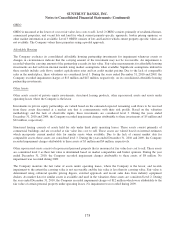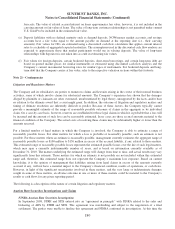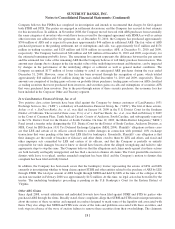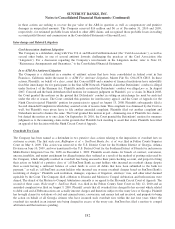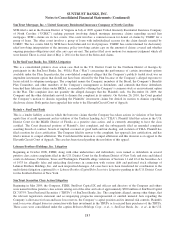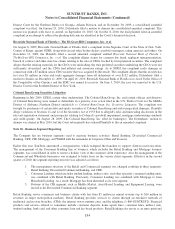SunTrust 2010 Annual Report Download - page 190
Download and view the complete annual report
Please find page 190 of the 2010 SunTrust annual report below. You can navigate through the pages in the report by either clicking on the pages listed below, or by using the keyword search tool below to find specific information within the annual report.SUNTRUST BANKS, INC.
Notes to Consolidated Financial Statements (Continued)
The Company has classified these CDs as level 2 instruments due to the Company’s ability to reasonably measure all
significant inputs based on observable market variables. The Company employs a discounted cash flow approach to
the host debt component of the CD, based on observable market interest rates for the term of the CD and an estimate
of the Bank’s credit risk. For the embedded derivative features, the Company uses the same valuation methodologies
as if the derivative were a standalone derivative, as discussed herein under “Derivative contracts.”
For brokered deposits carried at fair value, the Company estimated credit spreads above LIBOR, based on credit
spreads from actual or estimated trading levels of the debt, or other relevant market data. The Company recognized
estimated losses of $41 million, losses of $2 million, and gains of $7 million for the years ended December 31, 2010,
2009 and 2008, respectively, due to changes in its own credit spreads on its brokered deposits carried at fair value.
Long-term debt
The Company has elected to carry at fair value certain fixed rate debt issuances of public debt in which it has entered
into derivative financial instruments that economically converted the interest rate on the debt from fixed to floating.
The election to fair value the debt was made in order to align the accounting for the debt with the accounting for the
derivatives without having to account for the debt under hedge accounting, thus avoiding the complex and time
consuming fair value hedge accounting requirements.
The publicly-issued, fixed rate debt that the Company has elected to carry at fair value is valued by obtaining quotes
from a third party pricing service and utilizing broker quotes to corroborate the reasonableness of those marks. In
addition, information from market data of recent observable trades and indications from buy side investors, if
available, are taken into consideration as additional support for the value. Due to the availability of this information,
the Company determined that the appropriate classification for the debt was level 2.
For the publicly-traded fixed rate debt carried at fair value, the Company estimated credit spreads above U.S.
Treasury rates based on credit spreads from actual or estimated trading levels of the debt, or other relevant market
data. The Company recognized losses of $95 million, losses of $233 million, and gains of $391 million for the years
ended December 31, 2010, 2009 and 2008, respectively, due to changes in its own credit spread on its public debt
carried at fair value.
The Company also carries $290 million of issued securities contained in a CLO that have been consolidated under
newly issued accounting guidance at fair value in order to recognize the nonrecourse nature of these liabilities to the
Company (see Note 11, “Certain Transfers of Financial Assets, Mortgage Servicing Rights and Variable Interest
Entities,” to the Consolidated Financial Statements for a discussion of this consolidation). Specifically, the holders
of the liabilities are only paid interest and principal to the extent of the cash flows from the assets of the vehicle and
the Company has no current or future obligations to fund any of the CLO vehicle’s liabilities. The Company has
classified these securities as level 2, as the primary driver of their fair values are the loans owned by the CLO, which
the Company has also elected to carry at fair value, as discussed herein under “Loans and Loans Held for Sale –
Corporate and other loans.”
Beginning January 1, 2010, the Company changed its policy for recording transfers into and out of the fair value hierarchy
levels in response to amended U.S. GAAP. All such transfers are now assumed to be as of the end of the quarter in which the
transfer occurred, whereas, previously, the Company assumed transfers into levels to occur at the beginning of the quarter
and transfers out of levels to occur at the end of the quarter. None of the transfers into or out of level 3 have been the result of
using alternative valuation approaches to estimate fair values.
174


